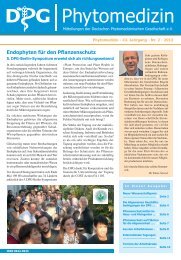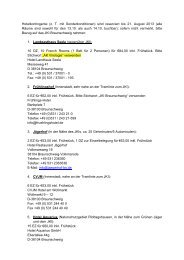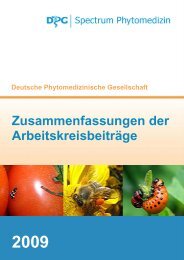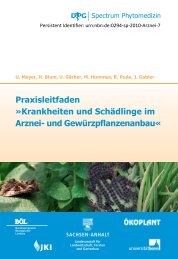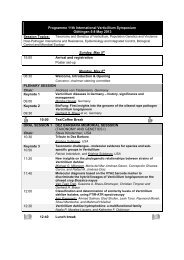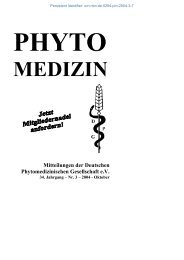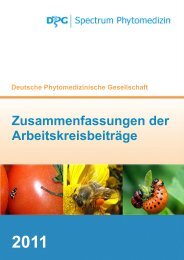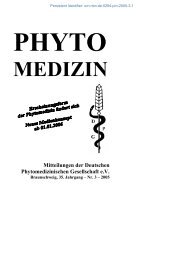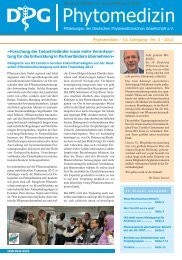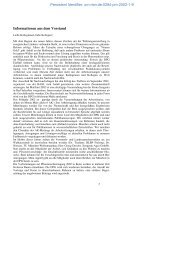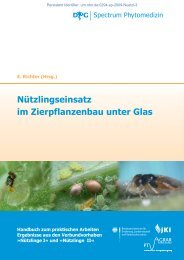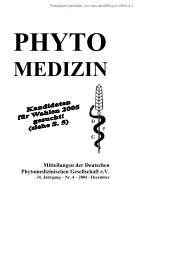fourth joint meeting of dutch and german
fourth joint meeting of dutch and german
fourth joint meeting of dutch and german
You also want an ePaper? Increase the reach of your titles
YUMPU automatically turns print PDFs into web optimized ePapers that Google loves.
The allelic resistance genes Tm-2 <strong>and</strong> Tm-22 against Tomato mosaic virus differ only in 4<br />
amino acids but recognize two independent domains <strong>of</strong> the ToMV MP<br />
A Gerhardts, M Strasser, M Silber und AJP Pfitzner<br />
Institute <strong>of</strong> Genetics, Department <strong>of</strong> General Virology, University <strong>of</strong> Hohenheim, Stuttgart<br />
E-mail: pfitzner@uni-hohenheim.de<br />
Transposon insertion experiments in tomato plants led to the isolation <strong>of</strong> the Tm-2 resistance gene<br />
against ToMV.. Sequence analysis revealed that Tm-2 codes for a 861 aa protein which belongs to<br />
the CC-NBS-LRR type <strong>of</strong> resistance genes. Surprisingly, Tm-2 contains only 4 amino acid<br />
exchanges located in two different domains <strong>of</strong> the protein in comparison to the allelic Tm-22,<br />
although sequence analysis <strong>of</strong> diverse resistance breaking virus strains proved that both resistance<br />
genes recognize different parts <strong>of</strong> the ToMV movement protein. Further investigations on the<br />
molecular interaction <strong>of</strong> these resistance genes with the ToMV MP indicated that Tm-2 <strong>and</strong> Tm-22<br />
contain two distinct domains for the interaction with the avirulence gene product.<br />
Functional analysis <strong>of</strong> RNAi suppressors <strong>of</strong> negative str<strong>and</strong> plant viruses<br />
JC Hemmes, EC Bucher, I Cahyani, E Buurman, RW Goldbach <strong>and</strong> M Prins<br />
Laboratory <strong>of</strong> Virology, Wageningen University<br />
E-mail: hans.hemmes@wur.nl<br />
In recent studies we have shown that the NSs protein <strong>of</strong> Tomato spotted wilt tospovirus (TSWV) as<br />
well as the NS3 protein <strong>of</strong> Rice hoja blanca tenuivirus (RHBV) suppress RNA silencing in plants.<br />
To further analyse the function <strong>of</strong> suppressor NS3 in N. benthamiana in RNA silencing, expression<br />
constructs <strong>of</strong> these proteins were produced resulting in the production <strong>of</strong> MBP tagged proteins in<br />
bacteria <strong>and</strong> plants (via A. tumefaciens infiltration). The addition <strong>of</strong> the fusion partner, included to<br />
facilitate pull down experiments, was shown not to interfere with the RNA silencing activity <strong>of</strong> the<br />
proteins. In subsequent experiments deletion mutants were generated. Two conserved domains <strong>of</strong><br />
the in NS3 protein were deleted. Both NS3 mutant proteins were proven to be expressed, while the<br />
RNA silencing suppression activity in plants was lost. Analysis <strong>of</strong> mRNA <strong>and</strong> siRNA levels<br />
compared to NS3 confirmed these observations <strong>and</strong> will be discussed. A series <strong>of</strong> point <strong>and</strong><br />
deletion mutations in the NSs protein was also produced <strong>and</strong> analysis will be presented. To further<br />
elucidate the biochemical function, in vitro RNAi experiments were performed <strong>and</strong> the function <strong>of</strong><br />
bacterial purified suppressors examined.<br />
Both TSWV <strong>and</strong> RHBV are transmitted by insects in the natural situation, <strong>and</strong> moreover are<br />
replicating in their insect vector. To further analyse the possible function <strong>of</strong> the RNAi suppressor<br />
proteins in insects, we set up RNAi (suppression) experiments in Drosophila S2 cells using eGFP<br />
as reporter. Using this system we were capable to show that S2 cells can efficiently silence the<br />
GFP transgene using specific siRNAs, hence RNAi is fully functional. Upon addition <strong>of</strong> the RNAi<br />
suppressor proteins, this effect was completely reversible indicating that NSs <strong>and</strong> NS3 are efficient<br />
RNAi suppressors in both plants <strong>and</strong> insects.<br />
Occurrence <strong>of</strong> short interfering RNA in virus-infected Cassava (Manihot esculenta) varieties<br />
with differential resistance /susceptibility against geminivirus infections<br />
K Dietrich <strong>and</strong> S Winter<br />
DSMZ Plant Virus Division, Braunschweig<br />
E-mail: k.dietrich@bba.de<br />
Geminiviruses are single str<strong>and</strong>ed DNA viruses that replicate in nuclei <strong>of</strong> infected cells, cause<br />
serious disease in cassava. It has been shown that these viruses despite their missing dsRNA<br />
phase within their replication can trigger post-transcriptional gene silencing (PTGS) in infected<br />
plants. We have therefore studied the accumulation <strong>of</strong> short interfering RNAs (siRNAs), in resistant<br />
<strong>and</strong> susceptible cassava varieties to correlate the appearance <strong>of</strong> these RNA species with recovery<br />
from infection <strong>and</strong> level <strong>of</strong> resistance. Northern analysis <strong>of</strong> RNA extractions prepared from virus<br />
infected cassava, hybridized with viral DNA-A <strong>and</strong> DNA-B specific probes revealed presence <strong>of</strong> two<br />
classes <strong>of</strong> virus specific siRNA. All cassava varieties infected with different virus species/strains<br />
revealed siRNA accumulation in symptomatic tissues, however hybridization analysis with genomic<br />
component DNA-A or DNA-B specific probes indicated that for certain viruses the primary target <strong>of</strong><br />
PTGS is within DNA-A while for others DNA-B is targeted. Still, high levels <strong>of</strong> siRNA accumulation<br />
12



